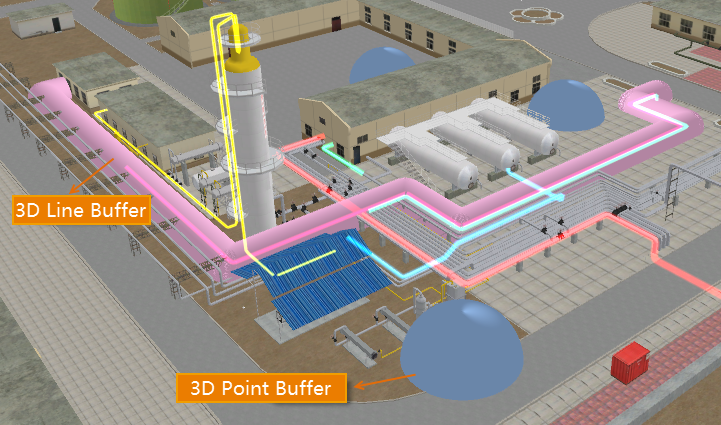3D Buffer
Feature Description
A 3D buffer refers to a sphere created around 3D points with specified radius, or a cylinder created around 3D line data with specified radius.
- Currently, this feature only supports creating buffer zones for 3D points and 3D line datasets.
- Parameter settings vary depending on data types. For line datasets, you can choose round or flat buffer types, while point datasets only generate round buffers.
Application Scenarios
- Danger zone analysis for explosives;
- Network signal coverage analysis;
- Radiation range analysis for radiation sources.
Feature Entry
- Spatial Analysis Tab -> Vector Analysis -> Buffer -> Select 3D Buffer from dropdown menu;
- Toolbox -> Vector Analysis tool -> Buffer -> 3D Buffer;
Parameter Description
You can select either 3D point dataset or 3D line dataset to create buffer zones. For 3D line datasets, you need to set buffer type as round or flat. The following example uses 3D line datasets to explain parameters in the "Create Buffer Zone" dialog:

- Basic Settings
- Datasource: Select the datasource containing the dataset for buffer creation.
- Dataset: Select the target dataset. The system automatically filters datasets under selected datasource, displaying only 3D point and line datasets.
- Parameter Settings
- Buffer type determines required parameters:
- Round: Draws parallel lines on both sides of the line with buffer distance, and connects buffer areas with semicircles at line endpoints. Default buffer type.
- Flat: Creates rectangular buffer areas by using adjacent line segments as one side and left/right radius as the other side.
- Buffer Radius: Input double values (10 decimal precision) between -1.79769313486232E+308 and 1.79769313486232E+308. Overflow prompts will appear for invalid values.
- Number of Arc Segments (4-200): Controls buffer boundary smoothness. Higher values create smoother boundaries. Valid range: 4-200. Default: 100.
- Buffer type determines required parameters:
- Result Data
Datasource: Select output datasource for buffer results.
Dataset: Enter output dataset name. Existing names will trigger invalid prompts requiring re-entry.
- Click "OK" to execute after configuring parameters.
Related Topics



